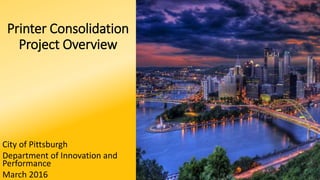Printer Consolidation Project Overview
- 1. Printer Consolidation Project Overview City of Pittsburgh Department of Innovation and Performance March 2016
- 2. Project Overview: • The purpose of this project has been, simply put, to cut printing costs. • Our plan is to remove printers where they’re crowded, encourage employees to use the newly networked Multi- Function Peripherals (MFP) as their primary printers, and challenge employees to better their printing habits by printing only what’s necessary, in black and white, and double-sided.
- 3. Overview of what we have found: • Found 352 networked printers throughout city, 112 MFP’s • Found cost of printing a page depending on printer used • Discovered that we are spending almost $300,000 dollars on toner costs alone. • Discovered that we have currently over 30 different models of printers within our municipal.
- 4. Statistics Black and White Printing by Ratio Departments Sorted by B/W Ratio Dept. b/w ratio PERMITS, LICENCES, INSPECTIONS 22% MAYORS OFFICE 30% EMERGENCY MEDICAL SERVICES 35% COUNCIL 47% DEPT OF PUBLIC WORKS 53% DEPT OF I&P 58% BUREAU OF BUILDING INSPECTION 58% MAYORS 59% DEPT OF CITY PLANNING 60% PARKS 63% EMERGENCY MGMT AGENCY 64% (NONE) 70% BUREAU OF FIRE 71% PERSONNEL: JTPA 76% PERSONNEL: PCSC 80% CONTROLLERS 85% BUREAU OF POLICE 87% LAW 95% COMMISSION ON HUMAN RELATIONS 96% DEPT OF FINANCE 98% PENSION 100% AVG 77% Duplexing by Ratio Departments Sorted by Duplex Ratio Dept. duplex ratio EMERGENCY MGMT AGENCY 0.0% MAYORS OFFICE 0.0% PENSION 0.0% PERMITS, LICENCES, INSPECTIONS 0.0% CONTROLLERS 0.8% BUREAU OF BUILDING INSPECTION 1.8% BUREAU OF FIRE 2.2% LAW 2.5% EMERGENCY MEDICAL SERVICES 5.7% PARKS 8.4% COMMISSION ON HUMAN RELATIONS 8.7% DEPT OF FINANCE 10.2% PERSONNEL: JTPA 10.7% (NONE) 10.7% PERSONNEL: PCSC 10.9% DEPT OF PUBLIC WORKS 13.5% BUREAU OF POLICE 18.0% MAYORS 20.4% COUNCIL 24.7% DEPT OF CITY PLANNING 42.2% DEPT OF I&P 46.3% AVG 14%
- 5. Sustainable Impact of Printing
- 6. Solutions • Centralized management of printers (Papercut MF, AMC360, PrinterLogic) • Reducing the fleet by the addition of MFP (Multi Functional Peripherals). • Identify and remove superfluous printers, especially those close by to MFP’s • Share the new printing policy: encouraging use of MFP’s, duplexing, black and white printing, and cutting superfluous printing. • Make sure all users are within 25-50 ft. of any printer at any time.
- 7. Questions???
- 8. THANK YOU!
Editor's Notes
- #3: The printing protocol among varying employees, departments, and offices throughout the city is very fragmented, there is no uniform standard that everyone follows. There are many different printer models used throughout the city, the quality of printing habits - black and white, duplexing, superfluous printing - vary significantly among differently employees, and the printer fleet throughout the city is bloated and too large to manage effectively by I&P.
- #4: This information that we have discovered, points to one glaring PROBLEM. And that is we have too many printers to properly manage them. As a result, we are unnecessarily losing money.
- #5: As you can see by the numbers, we have some opportunities for improvement in both of these categories.
- #6: This is just a sample of a month of printing here in the City of Pittsburgh. The time frame used is a slow point, but it shows you how much we actually print. We used almost 19 trees and 2,000kg of carbon in one month in the summer. We have to bring these numbers down!
- #7: Centralized management can be done in house, or by a third party vendor software like the ones mentioned here. All of the statistics that we compiled are from these three software solutions. Just as important is the printer policy. Change is hard, but if we decide to be the agents of change, the acceptance of the policy and best practices will be less painful for our users.








